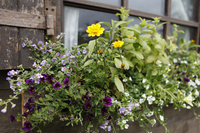Top tips for introducing herbs into your garden
 Bored with the usual blooms? Then why not take inspiration from Ricola’s Herb Garden of Natural Goodness, which has just scooped a Gold medal at the Gardeners’ World Live Exhibition, and think about getting creative with some herbs?
Bored with the usual blooms? Then why not take inspiration from Ricola’s Herb Garden of Natural Goodness, which has just scooped a Gold medal at the Gardeners’ World Live Exhibition, and think about getting creative with some herbs?Designed and brought to life by talented young designer Chris Myers of Chris Myers Garden Design, the garden was conceived to show that as well as all their functional benefits, herbs can be every bit as attractive as the usual garden staples such as roses or clematis.
Chris, who was returning to BBC Gardeners’ World Live for the fourth time, comments: “By just having them in a pot or a container at the back door for cooking, people are really not getting the most from their herbs. Few realise just how versatile and fragrant these plants can be and this is what this garden has been all about.
“We’ve tried to show off the beautiful rich green foliage, but have also got some pretty yellow, purple, blue and white flowers in there too – herbs are also a lot more colourful than many would imagine, and hopefully this Ricola garden will encourage British gardeners to have a go.”
Inspired by Ricola’s Alpine herb gardens in Switzerland, where the 13 herbs that give the sweets their great-tasting, refreshing flavours are grown, drifts of herbs formed the main feature of the garden, with plants such as sage, thyme, mallow and peppermint taking centre stage.
Not sure where to start when planning your own herb garden? Then follow these ten top tips from Chris Myers and the herb experts at Ricola and start creating your very own soothing retreat:
1. If short on space, herbs can be grown among other plants. Indeed low-growing herbs, such as thyme, make fantastic edging plants for flower borders, while mini hedges can be created from herbs like sage.
2. If you’re planning to harvest your herbs regularly, make sure they’re accessible so that you don’t have to trample on other plants to reach them.
3. Think about those areas in your garden where you like to relax and plant up with fragrant herbs. Also consider planting them along paths and near doors for a welcoming scent.
4. Some herbs do prefer drier conditions but will grow better and more pungently if watered regularly. Mornings and evenings are the best time of day for watering, and will let you catch the aromas at their best.
5. Fresh leaves can be picked as soon as there is enough foliage to support the plant. To maximise flavour and ensure good oil content, harvest after the dew has disappeared but before the sun becomes too hot.
6. Plant out herbs as soon as possible, as potting mixes are not always conducive to long growing periods.
7. Always cut herbs using a sharp knife and handle the plant as little as possible.
8. Most herbs prefer sun so a south-facing patch will often work best.
9. If planting a fast-growing herb such as lemon balm or mint, sink a bucket into the ground and plant it in that to avoid it spreading and overtaking the rest of the garden.
10. Most herbs can be propagated from cuttings. Take them after flowering and select stems that are firm and healthy and with a wooden heel. Trim the bottom leaves and place in a potting compost on a sheltered warm spot. Do not allow to dry out.
For more information about Ricola, visit winwithricola.co.uk, while for further details on Chris Myers visit chrismyersdesign.co.uk.

